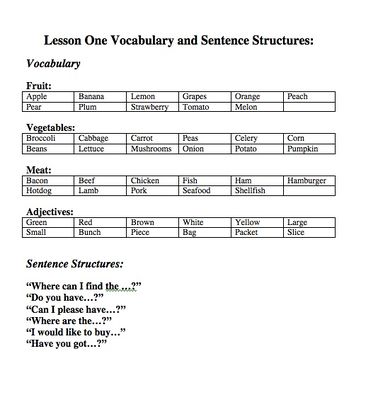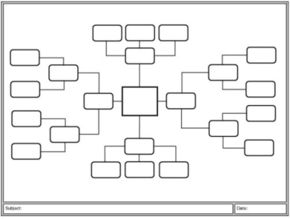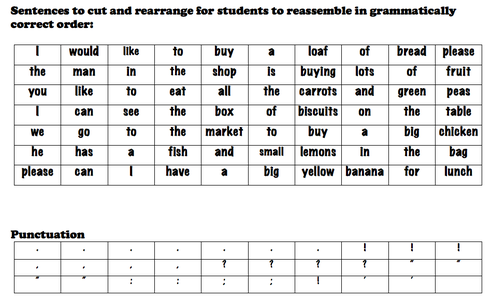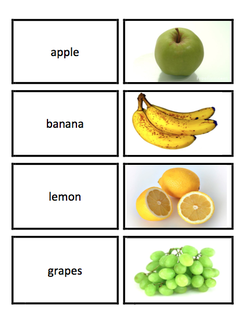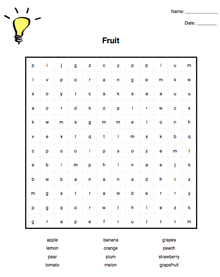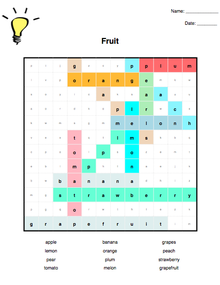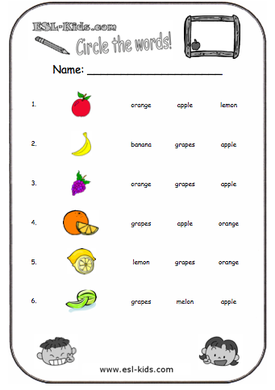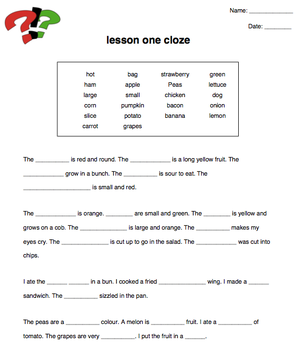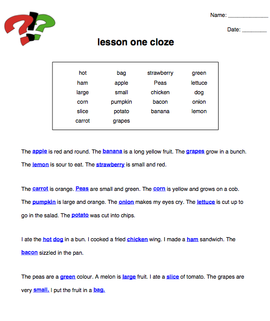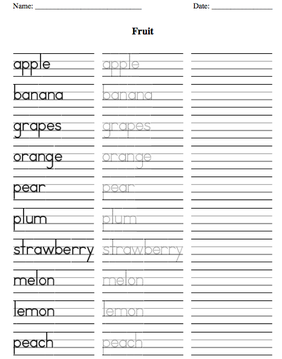Lesson One
|
Learning Intention: Students will identify and name objects found when food shopping and will also be able to understand and learn appropriate language on how to request them. Students will demonstrate developing knowledge of vocabulary and sentence structures through a reflective journal. Students will demonstrate developing knowledge of vocabulary and sentence structure through formal assessment practice at end of lesson. |
WALT (We Are Learning To):
1. Name a range of common food items found in a shopping situation.
2. Use appropriate sentence structures to ask for shopping items.
3. Monitor our own progress in this unit by recording reflections and evaluations in an on-going journal.
Success Criteria:
We will know we have achieved this when:
1. We have learnt 40 new shopping related words.
2. We are able to use 6 new sentence structures to ask for food items when shopping.
3. We have recorded reflective journal entries and scores in our journal as indicated during each lesson.
Learning Journal
(i) Students create title page for Learning Journal. Include unit title and an illustration. Teacher model and write title on board for students to copy.
(ii) Students head up Lesson One sub heading in learning journal. Teacher model and write on board for students to copy.
(iii) Students record WALT and Success Criteria under Lesson One.
Vocabulary
|
Vocabulary and Sentence Structures The following are the vocabulary and sentence structures used in this lesson: |
http://www.familylobby.com/common/tt6115628fltt.gif Students glue vocabulary sheet for Lesson One into learning journal.
Pre-knowledge
|
Through questioning the teacher will establish student’s background knowledge of food shopping vocabulary. |
Brainstorm Online
Using the Web 2.0 templates at Bubbl.us, children brainstorm all of the English words they know that relate to food shopping: bubbl.us
OR
Brainstorm Template
Using the attached template, children brainstorm all of the English words they know that relate to food shopping: File:Mindmap.pdf
http://www.familylobby.com/common/tt6115628fltt.gif Students add a copy of completed brainstorm into learning journal.
Sentence Structure
Students rearrange sentence pieces into grammatically correct sentence structures. Cut one sentence into individual words, mix up these word pieces and ask students to re-arrange the pieces into a grammatically correct sentence. Students could also be given all of these sentences cut into individual word pieces, and construct a grammatically correct sentence from the full range of sentences below (more difficult).
Activity One
Pronunciation
Students practice correct pronunuciation of vocabulary by listening to audio files. Students listen to vocabulary once and then repeat, practicing at the same time as audio play. Students may do this individually or in pairs, giving each other feedback.
Picture Cards
Use the below picture cards to introduce new vocabulary.
Flash cards for all vocabulary required for this lesson are attached here:
File:Vocabflashcards.pdf
Sentence Structure
Introduce grammatically correct sentence structure.
Task One The teacher prints the vocabulary out and cuts the sheets to get individual vocabulary words. The teacher then writes the target expressions on the board (this is after watching the video where the expressions are presented). The expressions are; Where can I find the ….? Do you have a…..? Can I please have a….? Where are the ….? I would like to buy ….? Have you got….? The students line up in two lines in the class. The teacher gives the students a set of five of the vocabulary cards by putting them on a desk in front of the first student in the line. The teacher chooses one expression and shouts “GO”. The first student picks up the top card, turns to the student behind and asks the target question. The second student must answer the question and then turn around to ask the same question to the next student and so on. The last student in the row then answers the question and runs to the front to put the card on the table and pick up the next card. The student then starts again by turning and asking the next student the question. The teacher could do this with five cards for the first expression, five for the next and so on so the students get used to saying the expressions.
Task Two The teacher prints off a set of vocabulary. She puts them on the floor (or on the desk) face up. The students get into two teams. The students all come around the cards so they can see the cards. One student from each team is chosen and they have to get ready to get the card. The teacher shouts out the name of an object on one of the cards and the student has to put their hand on the card. The first student to do that gets a point for their team (the teacher writes the name of the two teams on the board and then when one team wins a student from the winning team goes to the board to draw a picture of the object under their team name). The student who didn't pick up the card has to then use the target expression with the other student and the student who picked up the card replies. They then put the card down and the next two students in turn come to play the game.
Activity Two
Task i
Students will repeat the vocabulary to each other and use picture cards to request and give items eg, ”Have you got a green apple?”
As students become comfortable they can model appropriate actions as they practice the requests.
Task ii
Choose from the activities below for students to practice their vocabulary.
Word Find
File:Worksheet.pdf File:Vegewordsearch.pdf File:Meatwordfind.pdf File:Adjectiveswordfind.pdf
Multiple Choice
File:Multichoicefruit.pdf File:Multichoiceveges.pdf File:Multichoicemeat.pdf
Cloze Activity
http://www.familylobby.com/common/tt6115628fltt.gif Students glue completed activity sheets into their Learning Journal.
Task iii
Handwriting practice. Students complete the handwriting practice sheets below:
File:Writingfruit.pdf File:Writingveges.pdf File:Writingmeat.pdf File:Writingadjectives.pdf
http://www.familylobby.com/common/tt6115628fltt.gif Students glue completed handwriting worksheets into Learning Journal.
Task iv
Students plan and create their own word find, cloze activity or multi choice activity. Students share and complete each others created activities.
http://www.familylobby.com/common/tt6115628fltt.gif Students glue their created activities into their Learning Journal. Students get at least one peer reflection on their created activity to add to their Learning Journal underneath the actual activity (eg, PMI - plus, minus, interesting).
Assessment
Learning Journal
The teacher will conduct a vocabulary test to test the students’ retention of the vocabulary learnt in the lessons. The teacher will describe twelve words in English and the students write down the vocabulary in a list. The teacher could say for example: “It is long and yellow and monkeys eat it” The students can ask two questions in English. 1. How many letters? 2. What is the first letter? This is to help them in understanding the word. This is a very good listening exercise as well as a test for the students. At the end of the test the students swap tests and the teacher writes the answers on the board. The students mark each others’ work and then each student records their mark in their learning journal.
Formative
Ongoing teacher formative assessment of students. Teacher questions and reviews student progress providing formative feedback for individuals. Formative activities should be conducted across a range of whole class, group and individual activities regularly throughout the lesson. Feedback may be written or oral and may or may not be recorded for future reference as deemed appropriate by the teacher.
http://www.familylobby.com/common/tt6115628fltt.gif Teacher can make formative assessment comments in Learning Journal as appropriate.
Oral
Teacher gets students in small groups to practice exchanging food items and teacher assesses vocab and sentence structure by listening to learners pronouncing vocabulary. Teacher asks students to act out the given “request” sentence structures which they are learning.
Written
Written assessment task: Word Match. Teacher to mark.
http://www.familylobby.com/common/tt6115628fltt.gif Students glue completed and marked assessment into Learning Journal.
